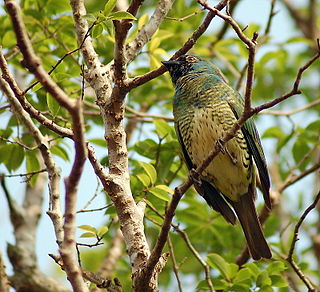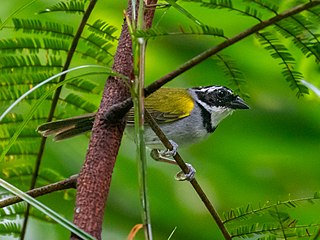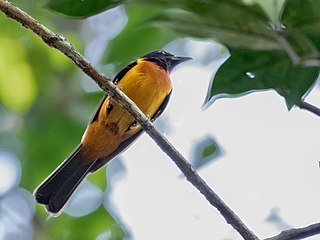
The avian genus Quiscalus contains seven of the 11 species of grackles, gregarious passerine birds in the icterid family. They are native to North and South America.

The genus Passerina is a group of birds in the cardinal family (Cardinalidae). Although not closely related to the buntings in the family Emberizidae, they are sometimes known as the North American buntings.

Pipilo is a genus of birds in the American sparrow family Passerellidae. It is one of two genera containing birds with the common name towhee.

The white-lined tanager is a medium-sized passerine bird in the tanager family Thraupidae. It is a resident breeder from Costa Rica south to northern Argentina and on the islands of Trinidad and Tobago.

Saltator is a genus of passerine birds in the tanager family Thraupidae that are found in Central and South America. They have thick bills, relatively long tails and strong legs and feet. Before the introduction of molecular genetic methods in the 21st century these species were placed in the cardinal family Cardinalidae.

The genus Sturnella are North American grassland passerine birds called meadowlarks. The genus was previously lumped with the South American meadowlarks now placed in the genus Leistes.

The magpie tanager is a South American species of tanager. It is the only member of the monotypic genus Cissopis. As suggested by its common name, this blue-black and white species is superficially reminiscent of a European magpie. With a total length of 25–30 cm (9.8–11.8 in), a large percentage of which is tail, it is the longest species of tanager. It weighs 69–76 g (2.4–2.7 oz).

Piranga is a genus of birds long placed in the tanager family, but now considered members of the family Cardinalidae. The genus name Piranga is from Tupi word tijepiranga, the name for an unknown small bird.

Lanio is the genus of shrike-tanagers in the family Thraupidae.

Tachyphonus is a genus of birds in the tanager family Thraupidae.

The black-goggled tanager is a species of bird in the family, Thraupidae. It is the only member of the genus Trichothraupis. It is found at low levels in forest and woodland in a large part of eastern and southern Brazil, eastern Paraguay and far north-eastern Argentina, with a disjunct population along the East Andean slope in Peru, Bolivia and far north-western Argentina. While generally common and widespread, and consequently considered to be of least concern by BirdLife International and IUCN, the population associated with the Andes is relatively local and uncommon.

The swallow tanager is a species of Neotropic bird in the tanager family Thraupidae. It is the only member of the genus Tersina. It is found widely throughout South America, from eastern Panama to far northern Argentina. The species is sexually dimorphic: the female is a yellow-green and the male a turquoise blue with a small deep black face and upper throat patch.

Monasa is a genus of puffbirds in the Bucconidae family.

Arremon is a genus of neotropical birds in the family Passerellidae. With the exception of the green-striped brushfinch which is endemic to Mexico, all species are found in South America, with a few reaching Central America.

The pectoral sparrow is a species of bird in the family Passerellidae. It is found in Bolivia, Brazil, Colombia, French Guiana, Guyana, Peru, Suriname, and Venezuela. Its natural habitat is subtropical or tropical moist lowland forests. The Brazilian name for this species is tico-tico-de-bico-preto, which in translation means "black billed sparrow".

The blue-backed tanager is a species of South American bird in the tanager family Thraupidae. It is the only member of the genus Cyanicterus.

The long-tailed reed finch is a species of South American bird in the tanager family Thraupidae. It is the only member of its genus Donacospiza.

The fulvous shrike-tanager is a South American bird in the tanager family Thraupidae. It is found in Brazil, Colombia, Ecuador, French Guiana, Guyana, Peru, Suriname, and Venezuela. Its natural habitat is subtropical or tropical moist lowland forests.

The hooded tanager is a species of bird in the tanager family Thraupidae. It is found in Argentina, Bolivia, Brazil, Colombia, French Guiana, Guyana, Paraguay, Peru, and Venezuela. Its natural habitats are subtropical or tropical moist lowland forest, subtropical or tropical mangrove forest, and heavily degraded former forest.

Ictinia is a genus of birds in the family Accipitridae. It contains two species that are native to the Americas.























